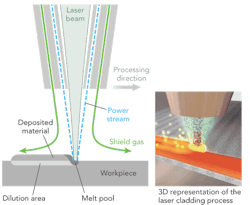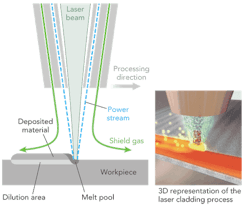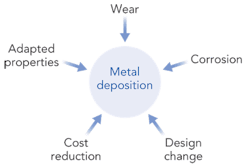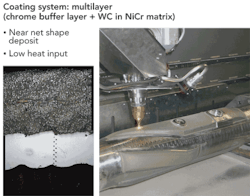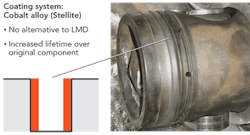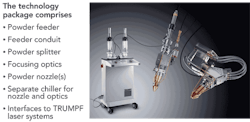Laser metal deposition defined
An overview of the technology, its advantages, and applications
High temperatures, enormous pressures, humidity, grinding, scouring, and radiation all take their toll – expensive parts wear down all too quickly. The problem is well known in aerospace applications, offshore drilling, automobile and commercial vehicle manufacturing, tool and mold construction, and a variety of other heavy industry applications. The additional time investment required to make relatively small model and design changes increases overall costs.
Laser deposition welding, also called laser metal deposition (LMD), is a generative laser procedure in which metal is applied on existing tools and components in layers. The laser generates a molten bath on the existing surface into which one or more metal powders is sprayed through a nozzle. The powder then melts and bonds with the base material. Bit by bit, a new material layer develops.
Using LMD to reduce manufacturing costs
Using LMD workpiece properties can be targeted for improvement by systematically refining or combining materials. For example you can give a softer metal a hard, high-quality surface; combine a thermally insulating material with a conductive layer; or coat metal with materials that resist high temperatures, salt water, or chemicals. Laser deposition will not only lengthen the life of your components, it will also significantly reduce the overall manufacturing costs.
FIGURE 1. In laser cladding, the laser beam melts powder particles and the base metal to form a metallurgical bond when cooled.
How can critical parts operating in tough environments be made to last longer? How can these valuable components be repaired so that their lifetime cost is lower? LMD might be the solution. It has been around since the 1970s when teams of scientists from places like Avco Everett Research Lab were performing every application that they could think of with their high-powered gas lasers. However, LMD hasn't become a mainstream application like laser cutting. The reasons might be that the capital cost has been too high to justify the process as compared to other heat sources, or the price for a new component was too low to justify a repair. Maybe the LMD process was not considered robust or repeatable enough to be used in more than a few select applications where there was simply no other practical solution. Regardless, it is a viable process that has been under-utilized until recently. The advent of higher-powered lasers, with beams that can be delivered through fibers and integrated into robust machine tools, decreased capital investment and operating costs of the laser device. This, in combination with the significantly increased cost of metals and the use of higher-performance materials, has caused many to rethink the use of the LMD process while producing new components or repairing used ones (FIGURE 1).
Advantages of a metallurgical bond
Extreme processes and competitive industries now require their components to have extremely long uptimes and high reliability, and for this they require processes that can extend the life of the parts. LMD produces a metallurgical bond that permanently attaches the deposited metal onto the base material, creating the best possible adhesion. The process itself is relatively simple: a laser beam produces a weld pool on the surface of a component. Powder jets blow a metallurgical powder into the weld pool coaxially to the working beam; the powder melts and is metallurgically bonded onto the base material. This enables new layers of metal with defined properties to be applied, even against the force of gravity (see FIGURE 2). Depending on the application, individual materials or powder mixtures consisting of different materials can be used, allowing the properties of the new layer to be very precisely defined. Iron, cobalt, titanium, and nickel alloys, as well as materials containing carbide, are all applicable. It is possible to choose a powder composition and the laser power in such a way that the carbides have a homogeneous distribution in the layer. For example, this enables tungsten or titanium carbides to be embedded into the deposited metallic matrix to increase the wear resistance of the component surface.
Other processes are also used in the deposition of powder (and wire), but there are significant limitations to consider. Some create a mechanical bond that does not hold as well as a metallurgical bond so that the coating fails sooner, requiring replacement or repair. Others require significantly more heat to melt both the powder and base material, which distorts the component to a higher degree, requiring a secondary operation to put it back into tolerance. The excess heat also causes heavy dilution of the base material into the coating, requiring two or three extra coating passes to achieve the chemical characteristics of the deposited material. This consumes significantly more powder, which is usually quite expensive, and of course requires more heat, which further distorts the part requiring even more post-process machining. The LMD process creates so little dilution that the coating is "at chemistry" within a few thousandths (~50-70 microns) and a coating depth of 0.060 inch (1.5 mm) is often all that's needed since the entire depth will be pure material.
FIGURE 2. The LMD process enables new layers of metal with defined properties to be applied, even against the force of gravity.
An example of this is a valve that is used to manage flow in a highly corrosive environment, such as high pressure steam or fluid. Stellite is usually used to coat the valve seat and it typically is deposited in powder form with a TIG welding process. A coating depth of up to 0.25 inch (6 mm) is required to achieve a 0.04 inch minimum depth of pure stellite due to the heavy dilution of the base material into the stellite coating. This requires several passes, each of which needs to be followed by a cooling period and possibly machining. The laser can accomplish this in one pass due to the low dilution, and the process is completed in one step with significantly less powder and little or no post processing.
Technological challenges and economic benefits
Despite its huge potential, laser deposition welding long remained a process confined to the laboratory. The main challenge lay in adequate process control – to achieve a homogeneous layer with the specified properties, the laser power, powder composition and the supply, frequently of multiple materials, must be precisely coordinated and controlled. However, manufacturers such as TRUMPF now offer complete technology packages for laser material deposition applications that guarantee proper control of these aspects.
They normally consist of three functional units – the powder feed, the processing optics with powder jet and the powder transfer line (which connects the feeder), and the optical system. For TRUMPF systems, the powder feed is normally a mobile unit with up to four independently programmable powder containers. The feeder combines the powder/gas mixture from the containers into a precisely adjusted powder mass flow. Sensors continuously monitor the composition of the flow, ensuring that there are no fluctuations in the metallurgical composition of the layer.
The economic benefits of this technology lie in the ability to add value to the component by depositing a layer or layers of material to significantly increase the operating life of expensive components that need to function reliably for long periods of time in expensive processes. The layer's properties allow operation in increased temperature or better corrosion and wear resistance.
Industry examples of success with LMD
One of the best known current applications is the hard-facing of drilling components for the oil drilling industry (see FIGURE 3). Typically, tungsten carbide is deposited onto the cylindrical-shaped component, which protects sensitive electronic devices from the drilling process as the rig is guided through the ground. A metallurgical bond is best for this since it provides the best protection and lasts the longest in operation. Precise control of the process parameters results in a finely-controlled deposition thickness and overlap, which requires less machining and overspray. Another example is wear-resistant blades for digging in the agricultural industry. The LMD process makes supplementary operations such as fusing the deposited layer or machining unnecessary. It also allows adjustment of the carbide content and setting of the layer thickness very accurately thanks to precise control of the process parameters. The end result is a premium product that has the ability to last a complete harvest season due to its superior bond.
The LMD process has the potential to grow in the repairing of expensive components that are still functional with the exception of localized wear that renders the part unusable. An often-analyzed application is the repair of aircraft turbine blades on turbine wheels that are machined from a solid block into a single, very high-value part known sometimes as a "blisk". The blades on such parts cannot be replaced, and if one of them is damaged, even slightly, the entire turbine wheel is rendered worthless. This is why aviation service companies are working hard on repair processes that enable damaged edges or broken tips to be reconstructed with the original geometry and material properties. Not only are the components expensive to make, the material is also quite costly and sometimes hard to get, and the ability to "recycle" these parts is attractive. The laser allows a fine bead of powdered aerospace material to be deposited with a minimum amount of heat, maintaining material properties and reducing thermal distortion.
FIGURE 4. Heavy duty: LMD of piston ring groove. On the pistons in four-stroke auxiliary diesel engines, there is increased load on the first piston ring groove
The marine engine industry also wants to repair used components, although the value of the material is not nearly as high as blisks. Instead, they are interested in ways to more easily and economically repair large quantities in a highly automated way. On the pistons in four-stroke auxiliary diesel engines, there is increased load on the first piston ring groove (FIGURE 4). This is more directly exposed to corrosion from the combustion gases and wear from hard particles in the fuel than the subsequent piston ring grooves. As a result, substantial wear can often be seen here, although the piston itself only demonstrates minimal wear, such as burnout on the piston crown. However, the damage from the ring groove wear is so significant that the entire piston has to be replaced or repaired. Until recently, there were no appropriate repair processes that enabled the original geometry of the groove to be restored. The requirements are good accessibility to the tight geometries, high precision and reproducibility, no damage to the basic material, no thermal distortion, a high level of automation, reduction of post-processing due to precise deposition location and thickness, and improvement of wear properties by selection of appropriate coating materials. Conventional deposition welding processes cannot achieve all of these requirements, particularly accessibility, reproducibility, and low thermal loads.
LMD: Uniquely meeting a need
The only technology that can meet the demands of this and the other processes is laser metal deposition. Because of the working distance, the laser beam and powder jets meet the requirement for processing very fine, difficult to access geometries. In addition, the processing head is compact enough that it can be guided by a robot or a small machine tool (see FIGURE 5). The beam and powder feed are both controlled by computer, resulting in a highly automated and therefore repeatable and economical overall system. In the case of pistons, laboratory tests show that the heat affected zone remains small, with a thickness of around 0.006 inch (150 µm), and does not influence the usage properties of the piston. With its homogeneous hardness distribution of 450 to 500 HV0.1, the new layer is actually more resistant than the original laser-hardened base material. Reconditioned pistons are currently being tested in the field and the results are promising, confirming what laboratory tests had already suggested. The reconditioned pistons are not only as good as new, they are actually better than new pistons. After 4500 hours of operation, engineers measured minimal wear, better than wear observed in the first ring groove on brand new pistons in the same machine.
Proof is in the pistons
The results are convincing and one engine manufacturer is interested in using the process, the goal being to offer a second production line alongside their new pistons made up of reconditioned pistons. The LMD process will give the company a way to compete with suppliers of cheap spare parts – a high-quality yet economical range of original parts with the manufacturer's guarantee. In addition, applications in the turbine, oil drilling, fluid management, and agricultural fields are showing encouraging results that justify the economics of the process.
FIGURE 5. Technology package for LMD. The processing head is compact enough that it can be guided by a robot or a small machine tool.
While there are many advantages to the LMD process, in summary this technology allows the extension of manufacturing components through a metallurgical bond that becomes one with the material while retaining the original geometry of the part. LMD technology keeps components strong and operational, and, because of the resulting economic advantages of this process, those manufacturers who use LMD operate from a position of strength.
David Locke is LMD account manager and regional sales manager for lasers at TRUMPF Laser Technology Center, email [email protected]. Antonio Candel-Ruiz is project manager, laser metal deposition, at TRUMPF in Germany.
Past ILS Issues
